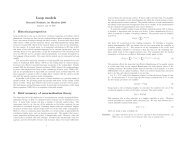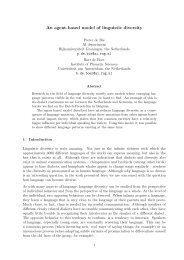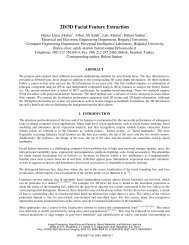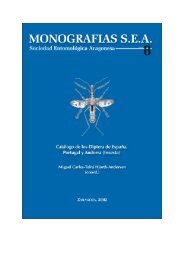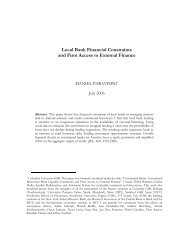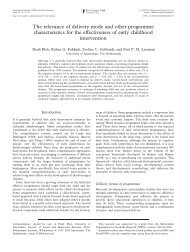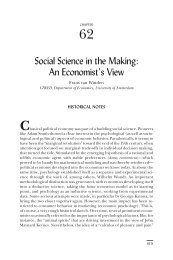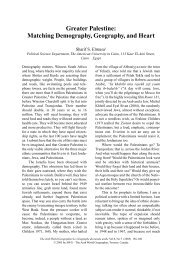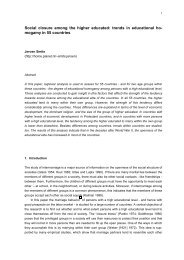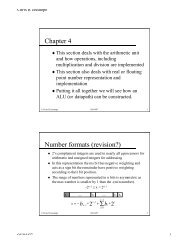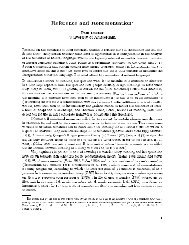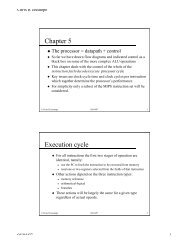Women's Scores on the Sexual Inhibition/Sexual Excitation Scales ...
Women's Scores on the Sexual Inhibition/Sexual Excitation Scales ...
Women's Scores on the Sexual Inhibition/Sexual Excitation Scales ...
Create successful ePaper yourself
Turn your PDF publications into a flip-book with our unique Google optimized e-Paper software.
WOMEN’S SIS=SES SCORES<br />
Janssen and colleagues (2002a) designed <strong>the</strong> to assess<br />
<strong>the</strong> tendency to resp<strong>on</strong>d sexually to a variety of erotic<br />
stimuli. The items <strong>on</strong> this measure c<strong>on</strong>sist primarily of<br />
‘‘if ...<strong>the</strong>n’’ statements (i.e., ‘‘If I am <strong>on</strong> my own watching<br />
a sexual scene in a film, I quickly become sexually<br />
aroused’’). Exploratory factor analysis of data provided<br />
by 408 male university undergraduates unexpectedly<br />
yielded three factors ra<strong>the</strong>r than two: <strong>on</strong>e related to sexual<br />
excitati<strong>on</strong> and two associated with sexual inhibiti<strong>on</strong><br />
(Janssen et al., 2002a). The excitati<strong>on</strong> factor (SES)<br />
describes sexual arousal stemming from social interacti<strong>on</strong>s,<br />
visual stimuli, fantasies, and n<strong>on</strong>sexual situati<strong>on</strong>s<br />
(such as bathing or lying in <strong>the</strong> sun). SIS1 focuses <strong>on</strong><br />
sexual inhibiti<strong>on</strong> due to threat of performance failure<br />
(e.g., difficulty getting aroused, losing arousal easily,<br />
c<strong>on</strong>cern about pleasing a partner, etc.). SIS2 assesses<br />
sexual inhibiti<strong>on</strong> due to potential c<strong>on</strong>sequences of sex<br />
(such as <strong>the</strong> risk of being caught=intruded up<strong>on</strong>, sexually<br />
transmitted diseases [STDs], unwanted pregnancy,<br />
and pain) (Janssen et al., 2002a). The three-factor structure<br />
was c<strong>on</strong>firmed in a sample of 459 undergraduate<br />
men, as well as a university-based sample of 313 male<br />
faculty and staff (Janssen et al., 2002a). Intercorrelati<strong>on</strong>s<br />
indicated that <strong>the</strong> excitati<strong>on</strong> factor (SES) and <strong>the</strong><br />
two inhibiti<strong>on</strong> factors (SIS1 and SIS2) were relatively<br />
independent (Janssen et al., 2002a, 2002b). SIS1 and<br />
SIS2 were related but not highly correlated (r ¼þ.26),<br />
suggesting that <strong>the</strong>y do not measure substantially overlapping<br />
c<strong>on</strong>structs.<br />
Results also suggested that SIS=SES scores showed<br />
acceptable test–retest reliability (r ¼þ.67 and þ.76 for<br />
<strong>the</strong> two samples) and good c<strong>on</strong>vergent=discriminant validity<br />
(Janssen et al., 2002a, 2002b). SES scores were modestly<br />
positively associated with scores <strong>on</strong> <strong>the</strong> Behavioral<br />
Inhibiti<strong>on</strong>=Behavioral Activati<strong>on</strong> <strong>Scales</strong> (BIS=BAS;<br />
Carver & White, 1994), <strong>the</strong> Neuroticism subscale of <strong>the</strong><br />
Eysenck Pers<strong>on</strong>ality Questi<strong>on</strong>naire (EPQ; Eysenck &<br />
Eysenck, 1975), and <strong>the</strong> Sociosexual Orientati<strong>on</strong> Inventory<br />
(SOI; Simps<strong>on</strong> & Gangestad, 1991), and more<br />
str<strong>on</strong>gly related to <strong>Sexual</strong> Opini<strong>on</strong> Survey (SOS) scores<br />
(Fisher, Byrne, White, & Kelley, 1988). See <strong>the</strong> Method<br />
secti<strong>on</strong> for a more detailed descripti<strong>on</strong> of <strong>the</strong>se measures.<br />
<str<strong>on</strong>g>Scores</str<strong>on</strong>g> <strong>on</strong> SIS1 and SIS2 showed some overlap: both<br />
were modestly positively associated with scores <strong>on</strong> <strong>the</strong><br />
Harm Avoidance Scale (MPQ-H). Only SIS2 scores,<br />
however, showed moderate negative correlati<strong>on</strong>s with<br />
SOS and SOI scores, and moderate positive relati<strong>on</strong>ships<br />
with scores <strong>on</strong> <strong>the</strong> Social Desirability Scale and <strong>the</strong><br />
BIS=BAS Behavioral Inhibiti<strong>on</strong> subscale.<br />
There are a number of reas<strong>on</strong>s to expect women and<br />
men to show different propensities for sexual inhibiti<strong>on</strong><br />
and excitati<strong>on</strong>. Bjorklund and Kipp (1996) suggest that<br />
gender differences in parental investment may have<br />
rendered sexual inhibiti<strong>on</strong> of particular importance to<br />
our female ancestors. Because reproducti<strong>on</strong> is associated<br />
with greater biological costs for females than for males<br />
(e.g., pregnancy), females especially would benefit from<br />
any mechanism that aids in c<strong>on</strong>trolling sexual desire and<br />
arousal (Wallen, 1995) and avoiding casual or opportunistic<br />
sex (Bjorklund & Kipp, 1996; Sym<strong>on</strong>s, 1979).<br />
In c<strong>on</strong>trast, our male ancestors may have benefited from<br />
higher levels of sexual excitati<strong>on</strong>. As <strong>the</strong> cost associated<br />
with fertilizati<strong>on</strong> is low, males may have increased<br />
reproductive potential by engaging in relatively indiscriminate,<br />
short-term mating with multiple partners<br />
(Buss, 1998; Knoth, Boyd, & Singer, 1988).<br />
Many reports of sexuality-related gender differences<br />
appear relevant to dual c<strong>on</strong>trol model processes.<br />
Research has found that males report earlier and more<br />
intense sexual arousal than females (Knoth, Boyd, &<br />
Singer, 1988), more frequent sexual desire (Beck,<br />
Bozman, & Qualtrough, 1991), and earlier, more<br />
frequent, and more varied sexual fantasies (Leitenberg<br />
& Henning, 1995). Men also spend more m<strong>on</strong>ey than<br />
women <strong>on</strong> sex, sexual products, and sexual entertainment<br />
(Baumeister, Catanese, & Vohs, 2001; Wallen,<br />
1995). In c<strong>on</strong>trast, women report less permissive attitudes<br />
regarding casual, premarital, and extramarital<br />
sex in comparis<strong>on</strong> with men (Clark & Hatfield, 1989;<br />
Cohen & Shotland, 1996; Oliver Hyde, 1993; Wuethrich,<br />
1993), as well as fewer desired (Buss & Schmitt, 1993)<br />
and actual lifetime sexual partners (Kinsey, Pomeroy,<br />
Martin, & Gebhard, 1953; Laumann, Gagn<strong>on</strong>, Michael,<br />
& Michaels, 1994; Wiederman, 1997). In a recent review,<br />
Baumeister and colleagues (2001) c<strong>on</strong>cluded that <strong>the</strong><br />
evidence for str<strong>on</strong>ger sex drive in men than women is ‘‘extensive,<br />
methodologically diverse, and c<strong>on</strong>sistent (p. 263).’’<br />
<strong>Sexual</strong> interest and expressi<strong>on</strong> clearly also are resp<strong>on</strong>sive<br />
to social influences (Hogben & Byrne, 1998). <strong>Sexual</strong><br />
attitudes and behaviors are related to a number of sociocultural<br />
factors, including educati<strong>on</strong>, religious affiliati<strong>on</strong><br />
and activity, marital status, and socioec<strong>on</strong>omic status<br />
(Kinsey, Pomeroy, & Martin, 1948; Laumann et al.,<br />
1994). More social c<strong>on</strong>trol of sexuality may be directed<br />
toward women than toward men (Crawford & Popp,<br />
2003), however, resulting in a sexual double standard.<br />
Female undergraduates report significantly more guilt<br />
associated with first intercourse than do males (Sprecher<br />
& Barbee, 1995), and female virgins report more positive<br />
and fewer negative emoti<strong>on</strong>s associated with <strong>the</strong>ir<br />
virginity than do males (Sprecher & Regan, 1996). In<br />
summary, <strong>the</strong> origins of gender differences in sexual<br />
behavior appear multifaceted, and <strong>the</strong> potential c<strong>on</strong>tributi<strong>on</strong>s<br />
of social c<strong>on</strong>structi<strong>on</strong> and biological factors<br />
deserve shared c<strong>on</strong>siderati<strong>on</strong> when interpreting data<br />
<strong>on</strong> sexual interest, behavior, and resp<strong>on</strong>se.<br />
Given extensive evidence for sexuality-related gender<br />
differences, Graham, Sanders, Milhausen, and McBride<br />
(2004) questi<strong>on</strong>ed whe<strong>the</strong>r <strong>the</strong> SIS=SES would be<br />
equally suited for use with women. Their specific c<strong>on</strong>cerns<br />
included <strong>the</strong> possibility that important influences<br />
<strong>on</strong> women’s arousal (such as reputati<strong>on</strong>, body image,<br />
37



